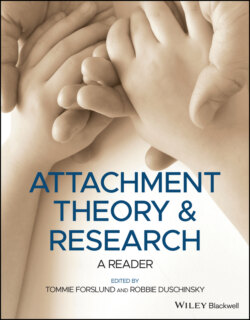Читать книгу Attachment Theory and Research - Группа авторов - Страница 21
Notes
Оглавление1 1 An abbreviated version of this paper was read before the British Psycho‐Analytical Society on 5 November, 1958.
2 2 Although in this paper I shall usually refer to mothers, it is to be understood that in every case I am concerned with the person who mothers the child and to whom he becomes attached, rather than to the natural mother.
3 3 This account is adapted from those given in Robertson and Bowlby (1952) and Robertson (1953a).
4 4 In the previous paper and the early drafts of this one the term ‘denial’ was used to denote the third phase. The problem of terminology is discussed more fully after the phase of detachment has been described.
5 5 As explained in my previous paper (Bowlby 1958), ‘the terms primary and secondary refer to whether the response is built‐in and inherited or acquired through the process of learning.’
6 6 See section ‘Ingredients of Separation Anxiety’ below.
7 7 For this abridged version a critical examination of psycho‐analytical theories relating to separation anxiety has been omitted. It is being published as a separate paper: Bowlby, J. (1960). Separation anxiety: A critical review of the literature. Journal of Child Psychology and Psychiatry, 1 (4), 251–269.
8 8 In an earlier paper (Bowlby 1957) I have used the term ‘instinctual response’ to refer both to the behaviour and to the hypothetical internal structure which, when activated, is presumed to lead to the behaviour. To avoid this confusion I am now using the term ‘instinctual response system’ for the hypothetical internal structure, and limiting the term ‘instinctual response’ to the active behavioural response, including both the motor behaviour pattern and its physiological and psychological concomitants.
9 9 A similar view, though coupled with a materially different theory of instinct, was advanced by McDougall (1923).
10 10 The possibility that a single emotion, fright, may accompany more than one instinctual response system suggests that Lorenz’s hypothesis that each response is accompanied by an emotional state peculiar to itself may need modification.
11 11 See the discussion by Thorpe (1950, p. 390). Several workers (e.g. Hinde 1954a) have shown that, paradoxically, strangeness evokes both escape and curiosity, and that there is a complex balance between the two competing response systems.
12 12 Such situations have been termed ‘consummatory situations’ by Bastock, Morris and Moynihan (1953) and by Hinde (1954b). In my view, however, partly because of the usefulness of the verb ‘to terminate’, a preferable term is ‘terminating situation’.
13 13 ‘The tendency for instinctual responses to be directed towards a particular individual or group of individuals and not promiscuously towards many’ (Bowlby (1958, p. 370).
14 14 The term ‘haven of safety’ has been introduced by Harlow and Zimmermann (1958). In describing their very interesting experiments with rhesus monkeys they write: ‘One function of the real mother, human or sub‐human, and presumably of a mother surrogate, is to provide a haven of safety for the infant in times of fear or danger.’ See also Harlow (1958).
15 15 The secondary drive theory, which they invoke to account for the child’s tie to his mother and for separation anxiety, is not necessary to an interpretation of their data.
16 16 In his experiments with goat kids Liddell (1950) has demonstrated the very different responses to fright‐evoking stimuli of identical twins according to whether or not they were with their mother: the twin with his mother roamed about naturally and seemed relaxed, whereas the one without his mother froze almost immobile in a corner of the room.
17 17 Of Schaffer’s twenty‐five subjects, sixteen were aged over 28 weeks and nine 28 weeks and under. Of the two younger infants who deviated from the usual behaviour, one was already 28 weeks of age, and so on the margin of the older age group, and the other was thought to be missing his dummy.
18 18 Anthony writes: ‘It would also follow that before the seventh month the infant cannot be separated from an object‐mother firmly and substantially localized in space, as an organized reality. His separation feeling must therefore lack the quality of separations at a later stage.’
19 19 See, for instance, Winnicott’s (1953) conception of the development of the false self and Balint’s (1952) of conditions which give rise to neurosis and the need for a ‘new beginning’.
20 20 Analytic literature is full of references to hatred arising in such situations. That separation from mother itself provokes it has been used by Freud (1920, p. 16) as a possible explanation of the cotton‐reel incident: ‘Throwing away the object so that it was “gone”, ‘he suggests, ‘might satisfy an impulse of the child’s … to revenge himself on his mother for going away from him’. Dorothy Burlingham and Anna Freud (1944), Spitz (1953), Robertson (1953a, 1953b) and Heinicke (1956) have all reported first‐hand observations of intensely hostile behaviour following separation. It is Fairbairn’s ([1951] 1952) view that the origin of the infant’s aggression towards his libidinal object, and therefore of his ambivalence, lies in the trauma of separation from mother and the consequent libidinal deprivation and frustration.
21 21 There is another situation which may lead a child to become excessively clinging and which may also masquerade as “spoiling.” It is when a mother, for unconscious reasons of her own, communicates to a child her desire that he should not leave her. This is a common finding in cases of so‐called school phobia (Johnson et al. 1941).
22 22 In a comparison of twenty 6‐year‐old children reported as overdependent with twenty controls, Stendler (1954) found that six of the over‐dependent children were ‘over‐protected’ and eleven had suffered major disturbances in their lives between the ages of 9 months and 3 years.
